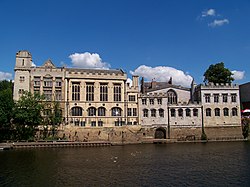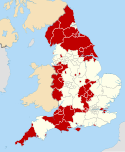City of York Council: Difference between revisions
→2023-Present: Typo Tags: Mobile edit Mobile web edit |
JackWilfred (talk | contribs) m nowrap |
||
| Line 32: | Line 32: | ||
: {{nowrap|{{Color box|{{party color|Labour Party (UK)}}|border=darkgray}} [[Labour Party (UK)|Labour]] (24)}} |
: {{nowrap|{{Color box|{{party color|Labour Party (UK)}}|border=darkgray}} [[Labour Party (UK)|Labour]] (24)}} |
||
; Opposition (23) |
; Opposition (23) |
||
: {{Color box|{{party color|Liberal Democrats (UK)}}|border=darkgray}} [[Liberal Democrats (UK)|Liberal Democrats]] (19) |
: {{nowrap|{{Color box|{{party color|Liberal Democrats (UK)}}|border=darkgray}} [[Liberal Democrats (UK)|Liberal Democrats]] (19)}} |
||
: {{Color box|{{party color|Conservative Party (UK)}}|border=darkgray}} [[Conservative Party (UK)|Conservative]] (3) |
: {{Color box|{{party color|Conservative Party (UK)}}|border=darkgray}} [[Conservative Party (UK)|Conservative]] (3) |
||
: {{Color box|{{party color|Independent}}|border=darkgray}} [[Independent politician|Independent]] (1) |
: {{Color box|{{party color|Independent}}|border=darkgray}} [[Independent politician|Independent]] (1) |
||
Revision as of 08:40, 9 May 2023
City of York Council | |
|---|---|
 | |
| Type | |
| Type | |
| Leadership | |
David Carr, Independent since 26 May 2022 | |
Claire Douglas, Labour since 5 May 2023 | |
Peter Kilbane, Labour since 5 May 2023 | |
Leader of the Opposition | Nigel Ayre, Liberal Democrats since 5 May 2023 |
| Structure | |
| Seats | 47 councillors |
 | |
Political groups |
|
Length of term | Whole council elected every four years |
| Elections | |
| Plurality-at-large voting | |
Last election | 4 May 2023 |
Next election | 6 May 2027 |
| Meeting place | |
 | |
| The Guildhall, York | |
| Website | |
| www | |
City of York Council is the municipal governing body of the City of York, a unitary authority in Yorkshire, England. It is composed of 47 councillors, one, two, or three for each of the 21 electoral wards of York. It is responsible for all local government services in the City of York, except for services provided by York's town and parish councils.
History
Municipal borough
The ancient liberty of the City of York was replaced in 1836 by a municipal borough, with city status, as a result of the Municipal Corporations Act 1835. As a municipal borough, the York Corporation was responsible for all local government services in the City of York. The municipal borough was expanded to serve the following areas:[1]
| Year | Area | Transferred from | Transferred to |
|---|---|---|---|
| 1836 | The City of York | - | City of York (municipal borough) |
| 1884 | The parish of Holgate and part of the parishes of Clifton, Dringhouses, Gate Fulford, Heworth, and Middlethorpe |
County borough
The municipal borough was replaced in 1884 by a county borough, with city status, as a result of the Municipal Corporations Act 1882. As a county borough, the York Corporation was responsible for all local government services in the City of York. When county councils were established for the East Riding, North Riding, and West Riding in 1889, as a result of the Local Government Act 1888, the City of York remained outside of their jurisdiction. The county borough was expanded and reduced in size to serve the following areas:[1]
| Year | Area | Transferred from | Transferred to |
|---|---|---|---|
| 1884 | The City of York | City of York (municipal borough) | City of York (county borough) |
| 1893 | Part of the parish of Clifton | - | |
| 1934 | Part of the parishes of Clifton Without, Heworth Without, Huntington, and Osbaldwick | Rural District of Flaxton | |
| 1937 | The parish of Middlethorpe Without and part of the parishes of Bishopthorpe and Dringhouses Without | Rural District of Bishopthorpe | |
| Part of the parishes of Acomb and Knapton | Rural District of Great Ouseburn | ||
| 1957 | Part of the parish of Askham Bryan | Rural District of Tadcaster | |
| 1968 | Part of the City of York | City of York (county borough) | Rural District of Flaxton |
| 1968 | Part of the parish of Heslington | Rural District of Derwent | City of York (county borough) |
| Part of the parish of Clifton Without | Rural District of Flaxton |
Non-metropolitan district
The county borough was replaced in 1974 by a non-metropolitan district, with city status, as a result of the Local Government Act 1972. As a non-metropolitan district, York City Council was responsible for some local government services in the City of York, with others being the responsibility of North Yorkshire County Council. The non-metropolitan district served the same area as the county borough:
| Year | Area | Transferred from | Transferred to |
|---|---|---|---|
| 1974 | The City of York | City of York (county borough) | City of York (non-metropolitan district) |
Unitary authority
The non-metropolitan district was replaced in 1996 by a unitary authority, with city status, as a result of the Local Government Act 1992. As a unitary authority, City of York Council is responsible for all local government services in the City of York, except for services provided by York's town and parish councils. The unitary authority serves the following areas:
| Year | Area | Transferred from | Transferred to |
|---|---|---|---|
| 1996 | The City of York | City of York (non-metropolitan district) | City of York (unitary authority) |
| The parishes of Hessay, Nether Poppleton, Rufforth, and Upper Poppleton | Borough of Harrogate | ||
| The parishes of Clifton Without, Earswick, Haxby, Heworth Without, Holtby, Huntington, Murton, New Earswick, Osbaldwick, Rawcliffe, Skelton, Stockton-on-the-Forest, Strensall, Towthorpe, and Wigginton | District of Ryedale | ||
| The parishes of Acaster Malbis, Askham Bryan, Askham Richard, Bishopthorpe, Copmanthorpe, Deighton, Dunnington, Elvington, Fulford, Heslington, Kexby, Naburn, and Wheldrake | District of Selby |
In October 2020, the UK government invited proposals for reform of local government in North Yorkshire, including the City of York.[2][3] The districts of Craven, Harrogate, Richmondshire, Ryedale, Scarborough and Selby submitted a proposal for an "East & West model" of two unitary councils in North Yorkshire, including the City of York. The two new councils would cover Ryedale, Scarborough, Selby and York in the east, and Craven, Hambleton, Harrogate and Richmondshire in the west.[4] The City of York Council submitted an alternative proposal to retain its existing status, and supported a proposal by North Yorkshire County Council for a single unitary authority for North Yorkshire (excluding the City of York). In July 2021, local government minister Robert Jenrick approved the alternative proposal.[5]
Under the new arrangements the two councils proposed to form a combined authority for York and North Yorkshire.[6] In August 2022 the government and the two councils agreed proposals for a devolution deal, which will require the formation of a combined authority and election of a directly elected mayor for the combined authority. The proposals are subject to a public consultation, and anticipate that elections for the first mayor would take place in May 2024.[7]
Political control
See City of York Council elections for historic elections, political control and leadership.
Since 2015 the council has been under no overall control. The leader of the council since 2019 has been Keith Aspden, a Liberal Democrat.
2015–2019
Conservatives and Liberal Democrats, holding 26 of the 47 seats, formed a joint administration to run the council in May 2015. Both parties are opposed to green belt development on the scale proposed by the Labour Party.[8] The working majority of the joint administration shrunk in February 2018 to 24 seats, when former council leader David Carr (Copmanthorpe Ward) and Suzie Mercer (Wheldrake Ward) quit the Conservative group and party,[9] Labour councillors Fiona Derbyshire and Hilary Shepherd resigned from the Labour Party in August to sit as Independent Socialists York.[10]

2019-2023
Due to no overall control, the Liberal Democrats and the Green Party, who hold 25 of the 47 seats between them, joined forces to form a coalition to run the City of York Council, announced by YorkMix on 14 May 2019. Support for the Liberal Democrats and Green Party in York increased at the poll. Both parties combined received more than 50% of the vote.[11]

2023-Present
The Labour Party won a majority of seats in the 2023 election, receiving 24 out of 47 seats leading to a one-seat majority. The Green Party lost all the seats they were defending to Labour, including that of council deputy leader Andy D'Agorne, while the Conservatives gained two seats from independent councillors while losing their leaders' seat in Strensall to the Liberal Democrats.

Lender option borrower option loans
The council has two lender option borrower option loans (LOBOs) worth £5 million. Each run until 2060 and 2077, with current interest rates of 3.66 percent and 3.8 percent. One of the loans was taken out in 2008, on a 69-year term, and the other in 2010, on a 50-year term.[12]
Social care
In October 2020 the council provided older people in the city with smart watches, which monitor a range of indicators including body temperature, heart rate, sleep patterns and step count. They are supported by sensors in their homes that can capture temperature and humidity, movement, how often doors open and close and power consumption. The service is provided by Sensing247 and North SP Group Limited and is intended to help people stay independent.[13]
References
- ^ a b Tillott, PM, ed. (1961). "The boundaries of the City". A History of the County of York: the City of York. Victoria County History. London: Victoria County History. pp. 311–321.
- ^ Peters, Dan (9 October 2020). "Three areas invited to submit unitary proposals". LocalGov.co.uk. Archived from the original on 15 October 2020. Retrieved 12 January 2021.
- ^ "Invitation for proposals for a single tier of local government" (PDF). 9 October 2020. Retrieved 21 December 2021.
- ^ "East & West full proposal goes to government". Get change right. Ryedale District Council. 10 December 2020. Archived from the original on 15 January 2021. Retrieved 12 January 2021.
- ^ "Next steps for new unitary councils in Cumbria, North Yorkshire and Somerset". GOV.UK. Ministry of Housing, Communities & Local Government. 21 July 2021. Archived from the original on 21 July 2021. Retrieved 21 July 2021.
- ^ "A unitary council for North Yorkshire. The case for change" (PDF). North Yorkshire County Council. p. 12. Retrieved 26 December 2021.
- ^ "York and North Yorkshire devolution deal". Department for Levelling Up, Housing and Communities. 1 August 2022. Retrieved 24 October 2022.
- ^ "Tories & Lib Dems to run York - Chris Steward to be leader - Labour ousted - First policies revealed". York Press. Newsquest Yorkshire & North-East. 18 May 2015. Retrieved 19 May 2015.
- ^ "Council in chaos as outgoing leader quits Tories over 'act of betrayal' - but council tax set". York Press. Newsquest Yorkshire & North-East. 22 February 2018. Retrieved 15 May 2018.
- ^ "Two councillors quit Labour but continue as Independent Socialists York". York Press. Newsquest Yorkshire & North-East. 7 August 2018. Retrieved 4 October 2018.
- ^ "Lib Dems and the Green Party join forces to run City of York Council". YorkMix. 14 May 2019. Retrieved 16 May 2019.
- ^ Victoria Prest (14 July 2015). "City defends long-term loans, amid national controversy". York Press. Newsquest Yorkshire & North-East.
- ^ "Smart watches trialed in York to help older people stay safe at home". Homecare Insight. 5 October 2020. Retrieved 16 November 2020.

